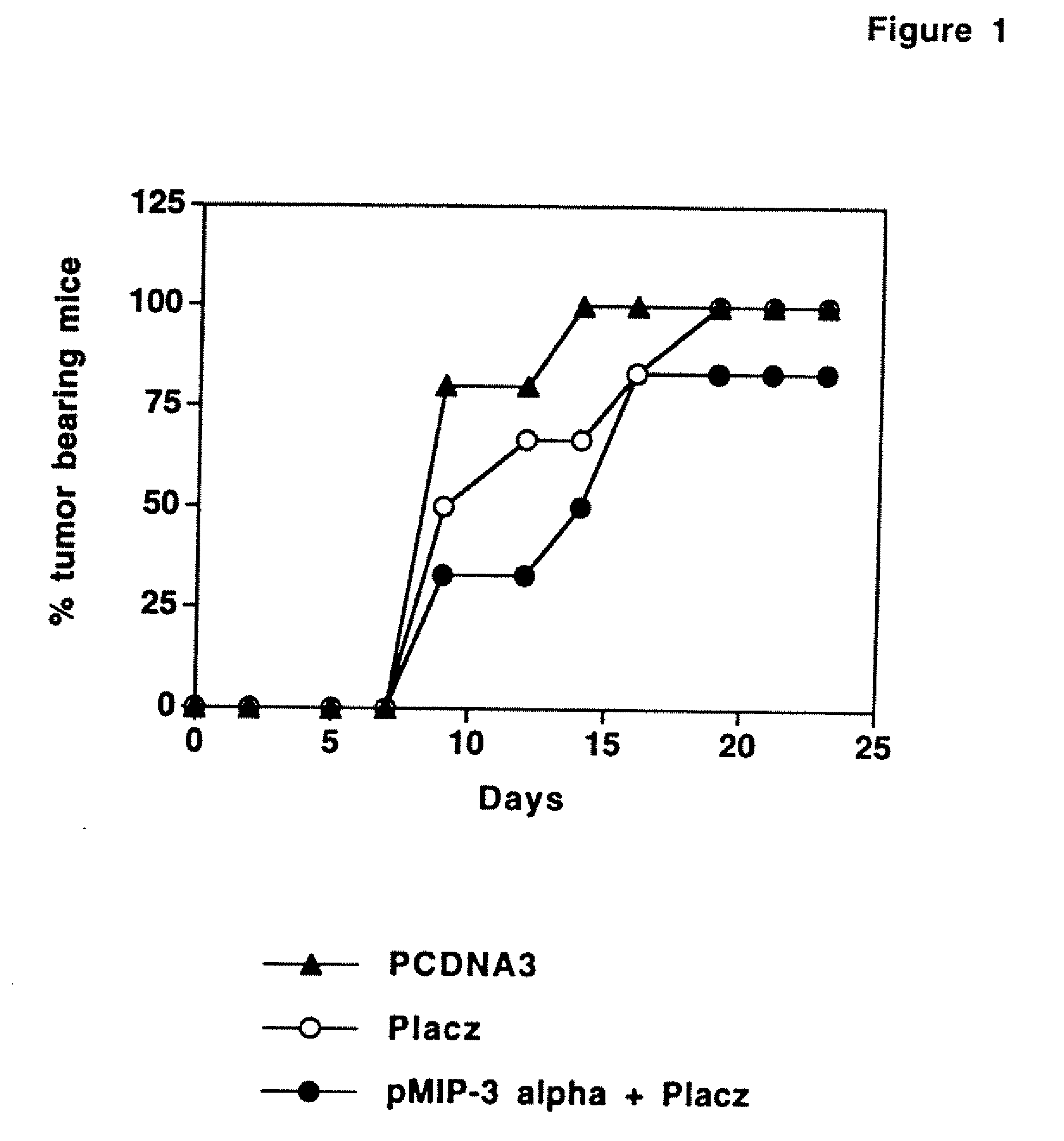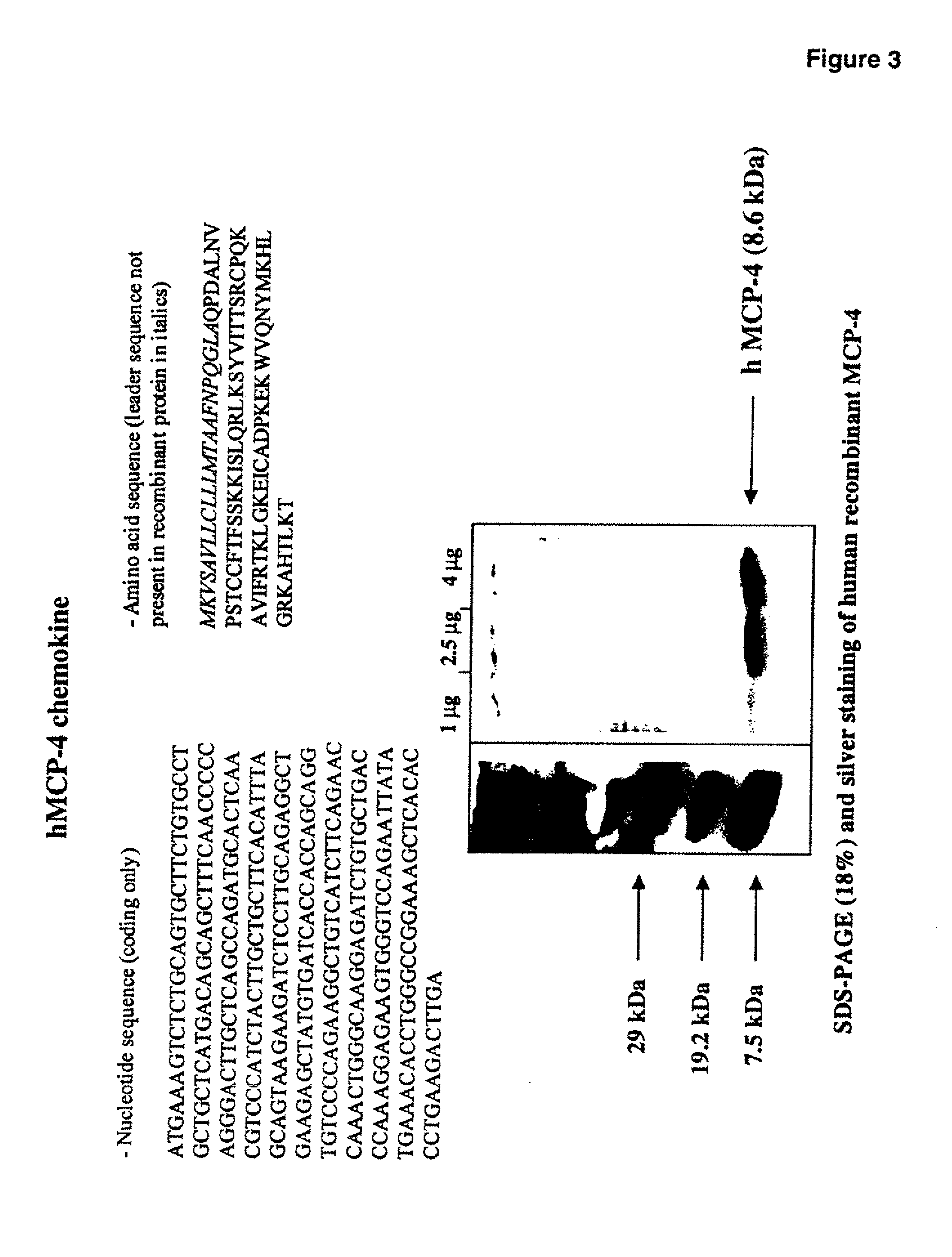Chemokines as adjuvants of immune response
a technology of immune response and chemokines, which is applied in the field of human chemokines, can solve the problems of complex signals regulating the traffic pattern of dc and are not fully understood, and achieve the effect of increasing the number of dc available and reducing the migration of immature dendritic cells
- Summary
- Abstract
- Description
- Claims
- Application Information
AI Technical Summary
Benefits of technology
Problems solved by technology
Method used
Image
Examples
example 1
Differential Responsiveness to MIP-3α and MIP-3β During Development of CD34+-derived DC
[0078] To understand the regulation of DC traffic the response to various chemokines of DC at different stages of maturation was studied. DC were generated from CD34+ HPC cultured in the presence of GM-CSF+ TNFα, and tested at different days of culture for their ability to migrate in response to chemokines in Boyden microchambers. MIP-3α and MIP-3β recruited 2 to 3 times more CD34+-derived DC than MIP-1α or RANTES. However, MIP-3α and MIP-3β attracted DC collected at different time points of the culture. The response to MIP-3α was already detected at day 4, maximal at day 5-6 and lasted until day 10. At day 13 to 14, the response to MIP-3α was usually lost. In contrast, the response to MIP-3β, which could not be detected before day 10, peaked at day 13, and persisted beyond day 15. Of note, at early time points, when most of the cells in culture were still DC precursors (CD1a−CD86−), the response...
example 2
Responses to MIP-3α and MIP-3β Parallel the Expression of their Respective Receptors CCR6 and CCR7 on CD34+-derived DC
[0081] To define the mechanisms of regulation of MIP-3α and MIP-3β responsiveness, the expression of their respective receptors CCR6 (Power, et al., 1997, J. Exp. Med. 186:825-835; Greaves, et al., 1997, J. Exp. Med. 186:837-844; Baba, et al., 1997, J. Biol. Chem. 272:14893-14898; Liao, et al., 1997, Biochem. Biophys. Res. Commun. 236:212-217) and CCR7 (Yoshida, et al., 199, J. Biol. Chem. 272:13803-13809) mRNA was studied by semi-quantitative RT-PCR. During DC development from CD34+ HPC, CCR6 mRNA was first detected at day 6, increased up to day 10 after when it decreased and became barely detectable at day 14. In contrast, CCR7 mRNA appeared at day 10 and steadily increased up to day 14. Moreover, CD40L-dependent maturation induced progressive down-regulation of CCR6 mRNA which became almost undetectable after 72 h, and up-regulation of CCR7 mRNA as early as 24 h....
example 3
The Response to MIP-3, β is also Induced Upon Maturation of Monocyte-derived DC
[0084] Monocyte-derived DC, generated by culturing monocytes in presence of GM-CSF+IL-4 for 6 days, are typically immature DC (CD1a+, CD14−, CD80low, CD86low, CD83−) (Cella, et al., 1997, Current Opin. Immunol. 9:10-16; Sallusto, et al., 1994, J. Exp. Med. 179:1109-1118). They migrated in response to MIP-1α and RANTES but neither to MIP-3α nor to MIP-3α. The lack of response of monocyte-derived DC to MIP-3α is in accordance with the absence of CCR6 expression on those cells (Power, et al., 1997, J. Exp. Med. 186:825-835; Greaves, et al., 1997, J. Exp. Med. 186:837-844). Upon maturation induced by TNFα, LPS, or CD40L, responses to MIP-1α and RANTES were lost while response to MIP-3β was induced. Like with CD34+-derived DC, the response to MIP-3β correlated with the up-regulation of CCR7 mRNA expression observed upon maturation induced by TNFα, LPS or CD40L. Again, up-regulation of CCR7 occurred at early t...
PUM
| Property | Measurement | Unit |
|---|---|---|
| time | aaaaa | aaaaa |
| saturating concentration | aaaaa | aaaaa |
| concentration | aaaaa | aaaaa |
Abstract
Description
Claims
Application Information
 Login to View More
Login to View More - R&D
- Intellectual Property
- Life Sciences
- Materials
- Tech Scout
- Unparalleled Data Quality
- Higher Quality Content
- 60% Fewer Hallucinations
Browse by: Latest US Patents, China's latest patents, Technical Efficacy Thesaurus, Application Domain, Technology Topic, Popular Technical Reports.
© 2025 PatSnap. All rights reserved.Legal|Privacy policy|Modern Slavery Act Transparency Statement|Sitemap|About US| Contact US: help@patsnap.com



